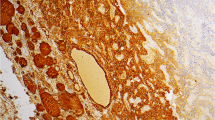Abstract
Tissue sections from 50 cases with thyroid tumors, composed of 11 follicular adenomas, 10 follicular carcinomas, 14 papillary carcinomas, 10 anaplastic carcinomas, and 5 medullary carcinomas, were immunohistochemically analyzed for representative neuroendocrine markers. Immunoexpression ratios of these neuroendocrine markers were as follows: Follicular adenomas, neuron-specific enolase (NSE) 63.6%, synaptophysin (SynP) 45.5%, Leu7 27.3%, NCAM 45.5%, chromogranin A (CgA) 0%, SNAP25 0%; follicular carcinomas, NSE 90.0%, SynP 80.0%, Leu7 80.0%, NCAM 0%, CgA 0%, SNAP25 0%; papillary carcinomas, NSE 85.7%, SynP 78.6%, Leu7 100%, NCAM 7.0%, CgA 0%, SNAP25.0%; anaplastic carcinomas, NSE 10.0%, SynP 0%, Leu7 0%, NCAM 0%, CgA 0%, SNAP25 0%; medullary carcinomas, NSE 100%, SynP100%, Leu7 80.0%, NCAM 40.0%, CgA 100%, SNAP25 100%. The two follicular carcinomas, which were morphologically characterized by "insular" (or "alveolar") arrangements, showed distinct immunoexpression of NSE and SynP at the same time. By in situ hybridization (ISH), expression of mRNA for NSE was confirmed in cases with marked immunoexpression of NSE. Although no endocrine granules were found, our results suggested that a specific type of follicular carcinoma, i.e., insular variant, may be immaturely neuroendocrine-differentiated.
Similar content being viewed by others
References
Chr, Hedinger. Definition and explanatory notes. In: Chr, Hedinger, ed. Histological typing of Thyroid tumours. 2nd ed. New York, Springer-Verlag, 5–14, 1993.
Ljungberg O, Boudeson L, Bondeson AG. Differentiated thyroid carcinoma, Intermediate type: A new tumor entity with feature of follicular and parafollicular cell carcinoma. 15:218–228, 1984.
Beltrami CA, Barbatelli G, Criante P, et al. Immunohistochemical study in thyroid cancer. 5:229–245, 1987.
Kargi A, Yauraukoglu K, Aktas S, et al. Endocrine differentiation in non-neuroendocrine thyroid carcinoma. Thyroid 6:207–210, 1996.
Ljungberg O, Ericsson UB, Bondeson L, et al. A compound follicular-parafollicular cell carcinoma of the thyroid: A new tumor entity? Cancer 52:1053–1061, 1983.
Kiji T, Branner RM. Localization of estrogen receptor messenger ribonucleic acid in rhesus monkey uterus by nonradioactive in situ hybridization with dioxigenin-labeled oligodeoxynucleotides. Endocrinology 132:382–392, 1993.
Oliva D, Barba G, barbieri G, et al. Cloning expression and sequence homologies of cDNA for human gamma enolase. Gene 79:355–360, 1989.
Papotti M, Negro F, Carney JA, et al. Mixed medullary-follicular carcinoma of the thyroid. A morphological, immunohistochemical and in situ hybridization analysis of 11 cases. Virchow’s Arch 430:397–405, 1997.
Wiedenmann B, Huttner WB. Synaptophysin and chromogranins/secregranins-widespread constituents of distinct types of neuroendocrine vesicles and new tools in tumor diagnosis. Virchows Arch [B] 58:95–121, 1989.
Gould VE, Wiedenmann BG, Lee I, et al. Synaptophysin expression in neuroendocrine neoplasm as determined by immunocytochemistry. Am J Pathol 126:243–257, 1987.
Khan A, Baker SP, Patwardhan NA, et al. CD57 (Leu 7) expression is helpful in diagnosis of the follicular variant of papillary thyroid carcinoma. Virchow Arch 432:427–432, 1998.
Sasaki H, Yoshida K, Ikeda E, et al. Expression of the neural cell adhesion molecule in astrocytic tumors: an inverse correlation with malignancy. Cancer 82:1921–1931, 1998.
Kaufmann O, Georgi T, Dietel M. Utility of 123C3 monoclonal antibody against CD56 (NCAM) for the diagnosis of small cell carcinomas on paraffin sections. Hum Pathol 28:1373–1378, 1997.
Vargas F, Tolosa E, Sospedra M, et al. Characterization of neural cell adhesion molecule (NCAM) expression in thyroid follicular cells: induction by cytokines and over-expression in autoimmune glands. Clin Exp Immunol 98:478–488, 1994.
Majo G, Ferrer I, Marsal J, et al. Immunohistochemical analysis of the synaptic proteins SNAP-25 and Rab 3A in human pituitary adenomas. Overexpression of SNAP-25 in the mammosomatotroph lineages. J Pathol 183:440–446, 1997.
Risinger C, Bennett MK. Differential phosphorylation of syntaxin and synaptosome-associated protein of 25kDa (SNAP-25) isoforms. J Neurochem 72:614–624, 1999.
Fletcher L, Rider C, Taylor CB. Enolase isozymes III. Chromatographic and immunological characteristics of rat brain enolase. Biochim Biophys Acta 452:245–252, 1976.
Verma M, Dutta SK. DNA sequences encoring enolase are remarkably conserved from yeast to mammals. Life Science 55:893–899, 1994.
Rider CC and Taylor CB. Evidence for a new form of enolase in rat brain. Biochem Biophys Res Commun 66:814–187, 1975.
Author information
Authors and Affiliations
Corresponding author
Rights and permissions
About this article
Cite this article
Satoh, F., Umemura, S., Yasuda, M. et al. Neuroendocrine marker expression in thyroid epithelial tumors. Endocr Pathol 12, 291–299 (2001). https://doi.org/10.1385/EP:12:3:291
Issue Date:
DOI: https://doi.org/10.1385/EP:12:3:291




